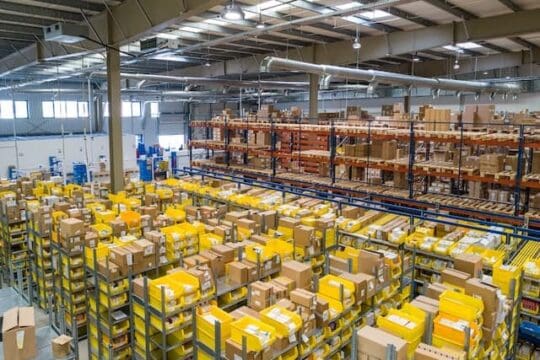7 Strategies to Organize Your Warehouse
Warehouses play a crucial role in any business’s operations, and it should come as no surprise that the number of warehouses worldwide increases each year. After all, these spaces are where businesses store their products and inventory before shipping them to retail outlets or delivering them to customers directly. Any problems at a business’s warehouse can slow down or even halt operations. This is a situation no business ever wants to be in. Such issues often arise when the warehouse is poorly organized.
If you’re interested in getting your warehouse organized and want to make your operations more efficient, you might be wondering where to start. In this guide, we will go over 7 simple strategies you can use to get your warehouse organized quickly.

1. Use Suitable Shelves, Racks, Bins, and Pallets
Organizing your warehouse is all about placing items in optimal storage areas and locations. For this reason, you should review how items are currently stored on shelves, racks, bins, and pallets.
You can also opt for better storage and shelving solutions such as flow-through racks, cantilever racks, push-back shelves, and drive-thru racks. Each of these storage solutions is useful for storing different types of items through suitable transportation methods.
For example, drive-thru racks are great for storing heavy items stacked on pallets that can only be moved using a forklift or pallet jack. Similarly, you can use cantilever racks to store bulky items with awkward dimensions rather than leave them on the warehouse floor where they may disrupt movement.
2. Group Items Based on Popularity
Your warehouse may contain a large number of product types, each of which may need to be retrieved at specific times. Many warehouses separate items into different categories based on the type of the product. For example, if you use your warehouse to store sporting goods, you may group all your fishing equipment together and your golf equipment elsewhere. This strategy may make sense at first, but it doesn’t take into account that certain fishing equipment or golf equipment is moved more frequently than others.
For this reason, it may make more sense to group items based on how often they are moved. So you can group fast-moving items together in one section of your warehouse, and group slow-moving items together in a different section. This ensures that warehouse staff won’t need to get slow-moving items out of the way to access fast-moving ones. Such an arrangement can improve your warehouse’s overall efficiency.
3. Warehouse Layout
The right warehouse layout can help improve operations and increase overall inventory accessibility. There are several options to automate and optimize your warehouse layout. The three main types of warehouse layout flow most often used by companies to organize the way their warehouse operates are U-shaped, I-shaped, and L-shaped.
With a warehouse layout, your organization can customize warehouse movement, reduce labor costs and increase overall productivity.
4. Set Up a Digitized Receiving Dock
If your warehouse doesn’t already have a receiving dock, now is the best time to add one. Having a receiving enables delivery trucks to park next to your loading area. This lets warehouse staff load and unloads items with greater efficiency.
You can also set up a digitized system where staff can apply and scan barcode labels to keep track of items entering and exiting the warehouse.
5. Label Your Shelves, Bins, and Racks
Another important strategy to keep your warehouse organized is to label shelves, bins, and racks. Labeling shelves, racks, and bins with barcodes is a very efficient way of tracking your inventory. Now by using a barcode scanner, you can make your picking easy and error-free. By labeling your locations, you can track inventory in real time and organize your warehouse more efficiently.
6. Rethink Shelf and Box Arrangements
It is also worth checking your warehouse’s storage capacity while reorganizing. This is important as there is a good chance you are underusing some space in certain regions.
So consider calculating your warehouse’s internal volume and comparing it with the volume of product boxes in the warehouse. If there seems to be a lot of extra space, you should observe how your shelves are spaced out. You could potentially move some shelves closer together to reduce wasted space and increase your storage capacity.
You can also check how much vertical space you have left and stack certain boxes higher accordingly when you organize your warehouse.
7. Use an Automated Warehouse Management System
An automated warehouse management system is one of the best tools you can rely on when organizing your warehouse. Without a system in place to keep track of your inventory/assets, it can pose a challenge for your employees to perform their tasks effectively. These systems are great because you can also utilize barcode scanners scanners and label printers to keep track of the inventory at all times.
Warehouse automation allows you to get a comprehensive overview of where everything is and identify any areas that could be reorganized. Many warehouse managers rely on such systems because they also help make operations more efficient and reduce errors. The act of managing thousands of items on a daily basis becomes a breeze when you know what needs to go where and when.
Final Thoughts
As you can see, managing a warehouse can seem challenging at first. However, there are plenty of ways to do this effectively. The strategies described above should be useful to any warehouse manager who is interested in organizing or reorganizing their warehouse to maximize productivity and efficiency.
Getting your warehouse organized is a great start, but maintaining this organization can also be tricky. For this reason, you should invest in a reliable automated warehouse management software that allows you to stay on top of warehouse activities and identify areas where improvements could be made.
Looking for more information on how we can help? Contact us to schedule a demo or learn more about how Kechie ERP Software can help streamline your business processes.

